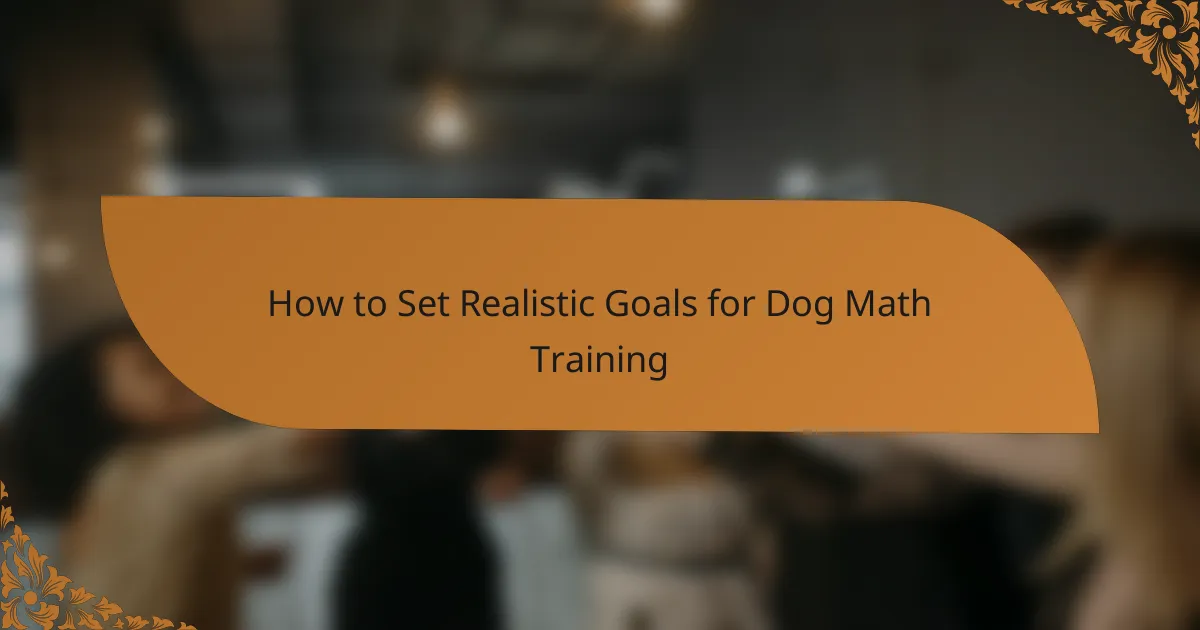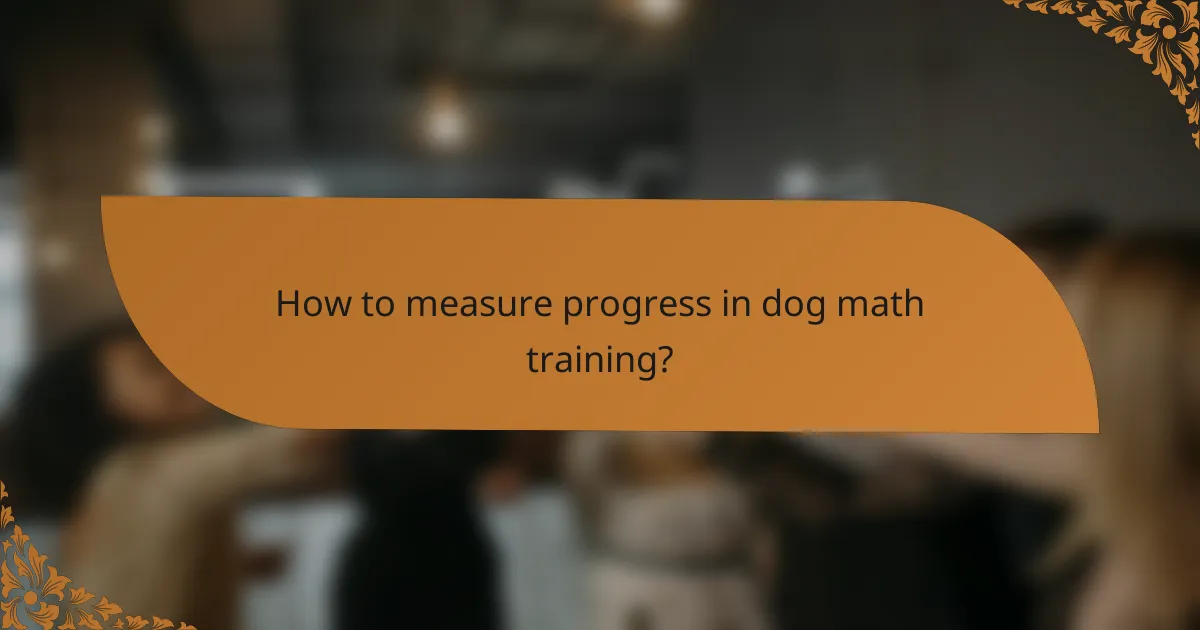Setting realistic goals for your dog’s math training journey is essential for fostering motivation and engagement. By identifying achievable milestones tailored to your dog’s unique abilities, you can create a structured learning environment that enhances cognitive skills and strengthens your bond. With the right tools and approach, both you and your dog can enjoy a rewarding training experience.

How to Set Realistic Goals for Dog Math Training
Setting realistic goals for your dog’s math training involves identifying achievable milestones based on your dog’s abilities and your training approach. This ensures that both you and your dog stay motivated and engaged throughout the learning process.
Define specific learning objectives
Specific learning objectives help clarify what you want your dog to achieve in math training. For example, you might aim for your dog to recognize numbers, perform simple addition, or respond to commands related to counting.
Break down these objectives into smaller, manageable tasks. Instead of aiming for your dog to perform complex calculations immediately, start with basic number recognition and gradually increase the difficulty as your dog masters each step.
Consider using a checklist to track progress on these objectives. This can include tasks like “Identify numbers 1-5” or “Perform addition with treats” to keep training focused and measurable.
Assess your dog’s current skills
Before setting goals, evaluate your dog’s existing skills in math-related tasks. This assessment will help you tailor your training plan to their current capabilities, ensuring that your objectives are realistic and achievable.
Observe how your dog interacts with numbers or counting tasks. For instance, if your dog can already recognize a few numbers, you can set a goal to expand that knowledge to a larger set. Use simple tests, like showing different quantities of treats and noting your dog’s responses.
Regularly reassess your dog’s skills as they progress. This will allow you to adjust your goals and training methods, ensuring that you continue to challenge your dog appropriately without causing frustration.

What are the benefits of structured dog math training?
Structured dog math training offers numerous advantages, including enhanced cognitive abilities and stronger bonds between dogs and their owners. By engaging in systematic training, dogs can learn to solve problems and respond to commands more effectively.
Improved cognitive skills
Structured math training stimulates a dog’s brain, promoting better problem-solving and critical thinking skills. Activities such as counting treats or identifying shapes can challenge their mental faculties and keep them engaged.
To implement this, start with simple tasks like teaching your dog to recognize the difference between one and two treats. Gradually increase complexity by introducing basic commands that require them to perform calculations, such as “fetch two balls.”
Enhanced owner-pet bonding
Engaging in structured training sessions fosters a deeper connection between you and your dog. As you work together to achieve goals, trust and communication improve, leading to a more harmonious relationship.
To maximize bonding, ensure training sessions are positive and rewarding. Use treats or praise to reinforce good behavior, and keep sessions short—around 5 to 10 minutes—to maintain your dog’s focus and enthusiasm.

What tools can help in dog math training?
Several tools can enhance your dog’s math training experience, making it more engaging and effective. Interactive apps and specialized games can provide structured learning and fun ways to reinforce mathematical concepts.
Interactive training apps
Interactive training apps are designed to make math learning enjoyable for dogs. These apps often feature engaging visuals and sound effects that capture your dog’s attention while teaching basic math skills like counting or simple addition.
When choosing an app, look for those that offer customizable difficulty levels to match your dog’s learning pace. Popular options may include features like rewards for correct answers, which can motivate your dog to continue learning.
Math games for dogs
Math games for dogs can be a fun way to reinforce math skills through play. These games might involve puzzles that require your dog to solve simple problems to receive treats or toys, blending learning with reward-based motivation.
Consider using items like numbered toys or treat-dispensing puzzles that require your dog to perform actions based on numerical cues. This hands-on approach can help solidify their understanding of basic math concepts while keeping them engaged.

How to measure progress in dog math training?
Measuring progress in dog math training involves assessing your dog’s skills and tracking the effectiveness of your training sessions. Regular evaluations and detailed records can help you identify areas of improvement and adjust your approach as needed.
Regular skill assessments
Conducting regular skill assessments is crucial for gauging your dog’s math abilities. Set aside time every few weeks to test your dog on specific tasks, such as simple addition or subtraction using treats. This not only helps you see improvement but also keeps your dog engaged and motivated.
When assessing skills, consider using a consistent scoring system. For instance, you might rate your dog’s performance on a scale from 1 to 5, where 1 indicates no understanding and 5 indicates mastery. This structured approach allows you to track progress over time and make informed decisions about future training.
Tracking training sessions
Keeping a detailed log of your training sessions is essential for measuring progress in dog math training. Record the date, duration, and specific exercises covered during each session. This information helps you identify patterns in your dog’s learning and adjust your training schedule accordingly.
Consider noting your dog’s responses during training, such as how quickly they completed tasks or any mistakes made. This data can reveal trends, such as whether your dog performs better at certain times of the day or after specific types of exercises. Regularly reviewing this log will help you refine your training strategy and enhance your dog’s learning experience.

What common challenges arise in dog math training?
Dog math training can present several challenges that may hinder progress. Common issues include a lack of motivation from the dog and difficulty in understanding the tasks presented.
Lack of motivation
A lack of motivation can significantly affect a dog’s willingness to engage in math training. Dogs may become disinterested if the training sessions are too long, repetitive, or not rewarding enough.
To combat this, keep training sessions short and fun, ideally lasting no more than 5-10 minutes. Incorporate treats or toys as rewards to maintain enthusiasm and encourage participation.
Difficulty in understanding tasks
Many dogs struggle to grasp the concepts involved in math training, which can lead to frustration for both the dog and the trainer. This difficulty often arises from unclear instructions or overly complex tasks.
To improve understanding, break down tasks into smaller, manageable steps. Use clear, consistent commands and visual cues to help your dog learn each concept before moving on to more challenging problems.

How to choose the right training method for your dog?
Selecting the right training method for your dog involves understanding their unique needs and learning style. A successful approach should align with your dog’s personality and the specific goals you have for their math training journey.
Consider your dog’s personality
Your dog’s personality plays a crucial role in determining the most effective training method. For instance, a highly energetic dog may thrive with interactive and engaging techniques, while a more reserved dog might benefit from a calm and structured approach.
Observe your dog’s reactions to different stimuli. If they respond well to praise and treats, positive reinforcement methods could be ideal. Conversely, if they seem anxious or distracted, consider a gentler, less stimulating environment for training.
Evaluate training styles
There are various training styles to choose from, each with its advantages and drawbacks. Positive reinforcement, for example, encourages desired behaviors through rewards, making it a popular choice among dog owners. However, it requires consistency and patience to be effective.
On the other hand, methods like clicker training can provide clear communication and immediate feedback, but they may require additional tools and practice. Assess your own preferences and capabilities, as well as your dog’s responsiveness, to find the best fit.

What are the prerequisites for effective dog math training?
Effective dog math training requires a foundation in basic obedience and an understanding of how dogs learn. These prerequisites ensure that your dog is receptive to learning and can engage with the training process effectively.
Basic obedience training
Before introducing math concepts, your dog should master basic obedience commands such as sit, stay, and come. These commands establish a framework for communication and help your dog focus during training sessions.
Start with short training sessions, ideally lasting between 5 to 10 minutes, to maintain your dog’s attention. Gradually increase the complexity of tasks as your dog becomes more proficient in obedience.
Understanding canine learning styles
Each dog has a unique learning style, which can affect how they respond to training. Some dogs may learn better through visual cues, while others might respond more effectively to verbal commands or hands-on guidance.
Observe your dog’s reactions during training to identify their preferred learning style. Adjust your approach accordingly, using methods like positive reinforcement or clicker training to enhance their engagement and retention of math concepts.

How to maintain consistency in training sessions?
Maintaining consistency in training sessions is crucial for effective dog math training. Regular, structured sessions help reinforce learning and build a strong foundation for your dog’s skills.
Establish a routine
Creating a consistent training routine helps your dog understand when to expect training sessions. Aim for short sessions, ideally lasting 5 to 15 minutes, conducted at the same time each day. This predictability can enhance your dog’s focus and retention.
Consider incorporating training into daily activities, such as during walks or mealtimes. For example, you can practice simple math commands like “sit” or “stay” before feeding your dog, reinforcing learning in a familiar context.
Use positive reinforcement
Positive reinforcement is an effective method to encourage desired behaviors during training. Reward your dog with treats, praise, or playtime immediately after they successfully complete a task. This creates a positive association with the training process.
Be mindful of the type of rewards you use. High-value treats, such as small pieces of chicken or cheese, can be more motivating than regular kibble. Adjust the rewards based on your dog’s preferences to keep them engaged and eager to learn.
